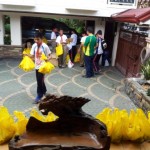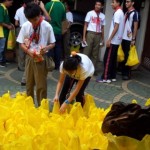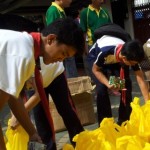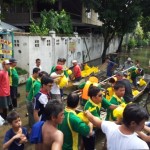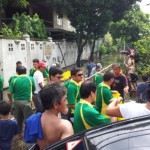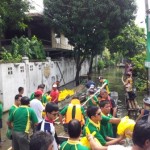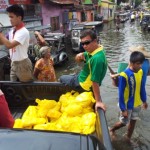4th Year Student named Richard Honrade made it on top!
House Acts On Bullying Problem
MANILA, Philippines – BULLYING has been a problem in most schools for sometime now. But it was only recently, after realizing that the growing number of children who drop out or experience physical and emotional harm is attributed to bullying, did we take appropriate action. The Anti-bullying Act of 2012 passed by the House of Representatives addresses the problem and provides vital information on how bullying can be prevented. While it is found in the early grades, it usually peaks in the later grades and the first years of high school. The Act defines bullying as the “use of written, verbal, or electronic expression or a physical act or gesture or any combination of these by one or more students directed at another student. It has the effect of placing the student in fear of physical or emotional harm.”
A study by Plan International and UNICEF (2008) had shown that 4 of 10 children in Grades 1 to 3, or 7 out of 10 in Grades 4 to 6 and high school were victims of bullying. Name calling, teasing, physical and verbal threat, shunning, malicious gossip, withdrawal of friendship are the more frequent acts used by bullies. Boys more often than girls are the bullies or the victims and they derive great satisfaction from inflicting pain on others. Among girls, bullying is more relational and is done through the spread of rumors or social exclusion. But the more serious repercussions are suicide or permanent psychological damage in that after dropping out, the child often refuses to return to school. A 2010 study showed that at least 160,000 children missed school out of fear of being bullied.
Cyber-bullying (over Internet, use of cell phones and other information technologies) has become more rampant. It is reported that about 2.7 million students have been bullied each year by about 2.1 million bullies on cyberspace using the popular social networks such as Facebook. The availability of new technologies, anonymity in cyberspace which works in favor of the abuser who does it with impunity, and the opportunities for sexual abuse and exploitation which the new technologies provide, are seen as factors contributing to the rise of cybercrime. Just recently, Senate Bill 2796, the Anti-Cyberspace bill, was approved with a few dissenters who invoked the principle of prior restraint against freedom of expression – that morality must not be legislated.
Large classes and poor classroom management that cause discomfort and restlessness had likewise exacerbated bullying behavior. Bullies are known to have problems at home, such as absentee parents and poor study habits. The bullied are often those coming from social, economic, or background that differs from that of the majority. Lack of confidence and self-worth make them unable to fight back.
Bullying is a system, according to child psychologist Dr. Honey Carandang. This means that we must understand the role of the third component, the “bystander.” In our normal cultural context, the bystander is a passive “usisero” who merely watches. If bullying must be successfully stopped, the bystander should be a concerned and active citizen. The teacher, a member of civil society, government are normally the bystanders in this system. Where there is abuse of power, such as in the example of the Ampatuan clan which planned the massacre, the worst case of electoral violence in Maguindanao, the government or the civil society must actively intervene.
Our present socio-economic and political environment, by perpetuating income and other forms of disparities, and by allowing impunity (or “getting away with murder”) to continue, had unwittingly contributed to creating a culture of bullying. Outside the school, we describe this as intimidation. We see it every day and everywhere – in the corridors of power – in the Legislature, the Judiciary, and Executive offices where the symbols of power and privilege still exist. Thankfully, the “wang-wang has disappeared from the streets, but we still have the pork barrel and the political dynasties with us. We are still helpless in giving due justice to victims of extra-judicial killings and protection of journalists and other endangered species.. My e-mail is florangel.braid@gmail.com
Congrats Doc!
Muli tayo’y Nagwagi!
Muli nanamang kinilala ang Talento at Galing ng mga magaaral sa Elementarya at Highschool ng Casa Del Niño San Pedro Campus sa katatapos na Ika-10 Norvic D. Solidum Inter-School Kompetisyon sa Wikiang Filipino.
Kinilala bilang Pangkalahatang Kampeon sa Elementarya at High School ang Casa Del Niño dahil sa pagkamit nito ng iba’t ibang gantimpala sa mga sinalihang patimpalak.
Mga Gantimpalang Natanggap:
Elementarya
Pangkalahatang Kampeon
Sabayang Bigkas – Kampeon
Sayawit – Ika-3 Gantimpala
Tagisan ng Talino Ika-2 Gantimpala
High School
Pangkalahatang Kampeon
Sabayang Bigkas – Ika-3 Gantimpala
Sayawit – Kampeon
Tagisan ng Talino – Ika-3 Gantimpala
Muli binabati namin ang lahat sa nakamit nating Tagumpay!
Mabuhay Casans!
Congratulations Nurses!
Congratulations to all Alumni who passed the Recently concluded Board Exam for Nurses.
Casa Del Niño – San Pedro
Anna Therese M. Aquino
Ma. Juania Isabel F. Nicano
Lynka Marla N. Brigola
Matt M. Vitales
Amor L. Vizcayno
Ana Fatima C. Marcial
Pamela S. David
Casa Del Niño – Ilagan Isabela
Georgia Bettina S. Asiddao
Congratulations CASANS!
*in case your name was not included in the list. Kindly send us a message at casadelninoschool@yahoo.com
Operation Tulong
Proclamation No. 455, s. 2012
MALACAÑAN PALACE
MANILA
BY THE PRESIDENT OF THE PHILIPPINES
PROCLAMATION NO. 455
DECLARING MONDAY, 20 AUGUST 2012, AS A REGULAR HOLIDAY THROUGHOUT THE COUNTRY IN OBSERVANCE OF EID’L FITR (FEAST OF RAMADHAN)
WHEREAS, Republic Act No 9177 declared Eid’l Fitr (Feast of Ramadhan) as a regular holiday throughout the country;
WHEREAS, Eid’l Fitr is celebrated by the Muslim World for three (3) days after the end of the month of fasting;
WHEREAS, to promote cultural understanding and integration, the entire Filipino nation should have the full opportunity to join their Muslim brothers and sisters in the observance and celebration of Eid’l Fitr; and
WHEREAS, in order to bring the religious and cultural significance of the Eid’l Fitr to the fore of national consciousness, it is necessary to declare Monday, 20 August 2012, as a regular holiday throughout the country.
NOW, THEREFORE, I, BENIGNO S. AQUINO III, President of the Philippines, by virtue of the powers vested in me by law, do hereby declare Monday. 20 August 2012, as a regular holiday throughout the country in observance of Eid’l Fitr (Feast of Ramadhan).
IN WITNESS WHEREOF, I have hereunto set my hand and caused the seal of the Republic of the Philippines to be affixed.
Done in the City of Manila, this 13th day of August, in the year of Our Lord, Two Thousand and Twelve.
(Sgd.) BENIGNO S. AQUINO III
By the President:
(Sgd.) PAQUITO N. OCHOA, JR.
Executive Secretary
Know more about Dengue!
On 27 July 2012, the Department of Health (DOH) reported that there has been a 16% increase in the incidence of dengue cases versus 2011 figures. In this light, we would like to re-issue the following reminders to the community.
What is Dengue?
It is a disease caused by a virus of the genus flavivirus.
What are the signs and symptoms of dengue?
High continuous fever lasting for 2-7 days, nausea, vomiting, abdominal pain, body weakness, bleeding tendencies from nose and gums, persistent red spots on the face, extremities and trunks are the most common manifestations of dengue fever.
How can a person be infected with dengue?
If a person is bitten by a female Aedes aegypti mosquito that is infected by the virus, that person may manifest signs and symptoms of the disease.
What are the danger signs of dengue?
Spontaneous bleeding, persistent vomiting, cold and clammy skin, listlessness, weak and rapid pulse, difficulty breathing.
Is there a treatment for dengue?
The management of dengue is directed at specific signs and symptoms. Paracetamol is given for fever; Aspirin should not be given. Sufficient water intake aims to hydrate the patient. If fever or symptoms persists for 2 or more days, the patient should be brought to the hospital.
What is the role of fumigation in the prevention of dengue?
Fogging is used to kill adult mosquitoes infected with the virus, to immediately stop transmission. It will not kill the larvae of mosquitoes which become adults in 7- 8 days.
How can dengue fever be prevented?
-
- Destruction or elimination of breeding containers, such as: bottles, drums, and used tires, by cleaning clogged gutters, and by turning flower vases upside down every 7 days.
- Spraying the areas with mosquitoes with insecticides.
- Application of insect repellents to the skin when going to places with mosquitoes.
- Use of long-sleeved shirts and long pants during seasons when dengue infection is rampant.
Casa Del Niño is relentlessly doing its part in preventing dengue fever. Measures that CDN is taking include:
- Fumigating the grounds once a month.
- Spraying the classrooms and toilets at least once a day.
- Spraying garden areas twice a month, using a substance that kills insects including mosquitoes that thrive in areas where there are plants.
- Meticulous elimination of all stagnant water.
- Monitoring dengue cases that are reported through the Health Services Office.
- Constant communication with the Department of Health for updates on dengue fever.
References:
http://www.doh.gov.ph/node/607
Philippine Daily Inquirer, July 27, 2012 issue, page A11
Manila Bulletin: Islanders Keep Wheels Of Education Rolling
By LEO ORTEGA LAPARAN II/MB Research Head
August 5, 2012, 6:31pm
MANILA, Philippines — Despite being separated from the Luzon mainland by a treacherous strait, Camiguin Norte Island in Calayan, Cagayan, manages to make things work, as far as sustaining an educational system is concerned.
The Department of Education (DepEd) sees to it that the teachers are fully utilized. In extreme situations a teacher handles more than one grade or year level, according to Education Secretary Armin Luistro.
“We also have the alternative learning system (ALS), which benefits those who cannot afford formal schooling,” Luistro said. “With ALS, we are able to provide an alternative to formal education by opening more educational opportunities to students with varying status in life, interests and capabilities.”
Barangay Balatubat Chairman Crispiniano Tugade says there is an alternative learning school in Camiguin Norte, “which I see as the only hope for schoolchildren who cannot afford to study.”
Under the ALS, “Mobile Teachers” are assigned to rural and depressed areas to teach unemployed adults, industry-based undergraduate workers, or members of cultural minorities.
In remote areas like Camiguin Norte, the Mobile Teachers are invaluable.
ALS classes are held in community learning centers or barangay halls. Integration begins with students attending a 10-month learning and review session administered by the Mobile Teacher, after which performance assessment prepares students for the Accreditation and Equivalency test (A&E).
If they pass either the elementary or secondary level, they receive a certificate, which gives them a chance to enroll in college or to take technical-vocational courses.
The problem, Tugade said, is “even if students get accelerated, spending to sustain their children’s education is still the biggest problem of parents.”
“That is why if the authorities wish to help, the best way is to make school facilities here better and to address the needs of schoolchildren,” he said.
Scholarship grants are most welcome. Camiguin Norte has “a number of out-of-school youths—high school graduates who cannot pursue college because they are too poor,” Tugade said.
Luistro stressed the importance of working hand-in-hand with local authorities, especially in far-flung areas.
“We maintain a good relationship with the local government unit and the community as we consider them our partners in education,” he said. “We also have very good principals who are able to manage whatever amount they receive as MOOE (Maintenance Operations and Other Expenditures) to ensure that students needs are addressed.”
Tugade echoed the sentiments of many teachers in Camiguin Norte that the upkeep of schools is are their biggest problem.
“We have a lot of students at the (Camiguin) elementary school, but four of the main building’s rooms are dilapidated. Of course, we also need more school materials,” he said.
“But if there are items and there is no place for storage, it is useless,” Lyceum of Camiguin officer-in-charge Marcelino Antonio said.
“Not that I’m belittling the situation, but life for us here in Camiguin Norte is really hard, especially if you have children you need to send to school. As you can see, our main source of livelihood are fishing and farming,” he said.
Food is not a problem. Almost everyone here has his own land to till. After plowing the fields, others can also go fishing,” Antonio said.
DepEd: Hold your horses on Sept. school opening
Moving the school opening to September would need a thorough study and consultations with education stakeholders and disaster management agencies, the Department of Education (DepEd) said Thursday.
DepEd Communications Director Tina Ganzon made the statement following renewed calls toreset the school opening to September from June to avoid the onset of the rainy season.
Ganzon, however, cited a survey that said more people favored retaining the opening of the school year in June, the traditional start of classes in the country.
“A survey conducted among parents, students and teachers in 2009 showed that the majority still preferred a June opening,” Ganzon told the Inquirer Thursday.
“But we are not saying no to the proposal to move it to September. This would need further study and consultations as we need to take into consideration a lot of factors including climate change,” she said.
A perennial proposal that never got anywhere, calls to move the class opening to September cropped up again following severe flooding in many parts of Metro Manila and other parts of Luzon that caused the suspension of classes earlier this week.
But strong storms and typhoons also hit the country in September, like “Ondoy,” which flooded Metro Manila in 2009 and “Sendong,” which devastated Cagayan de Oro and Iligan cities in 2011.
In the 1960s, the school opening was moved to September in a three-year process but this was quickly returned to June in the fourth year after students complained that they could notconcentrate on their school work due to the hot summer weather in April and May, and the fact that farmers in the provinces could not enlist their children’s help in bringing in the harvestsbecause they were in school.
Source:
Inquirer.net















